New Boston Historical Society
New Boston, New Hampshire
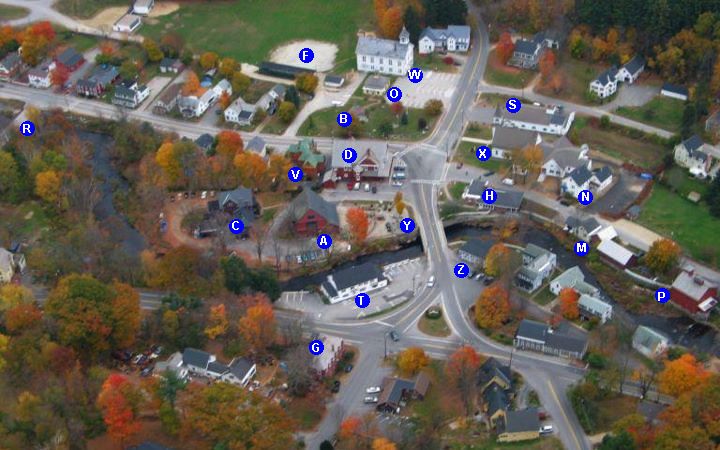
A Bird's-Eye View of New Boston Village
The architecture of New Boston village differs from that of the traditional New England town.
Instead of white colonial buildings set around a village green, New Boston also has some colorful buildings in a Victorian style.
This is due to the Fire of 1887 which burned most of the village.
Let's explore some of the history of New Boston village.
You may click on any of the points of interest in the photo above.
For example, if you click anywhere near the (D) by Dodge's Store, you should see more information about Dodge's Store. Click your browser's "back" button (←) to return to the photo.
If you prefer, you may scroll down to photos and text below.
We thank Ken Cuneo for the wonderful aerial photo!
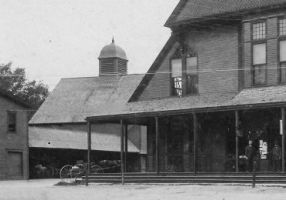 [A]
The Apple Barn built by J.R. Whipple stands near the site of Abram Wason's barrel-head factory. Sparks from Wason's workshop are believed to be the cause of the 1887 fire which destroyed most buildings in the village, except for Wason's.
[A]
The Apple Barn built by J.R. Whipple stands near the site of Abram Wason's barrel-head factory. Sparks from Wason's workshop are believed to be the cause of the 1887 fire which destroyed most buildings in the village, except for Wason's.The Apple Barn is now New Boston Hardware. (Does anyone know when it lost its cupola?)
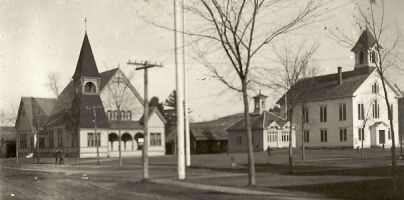 [B]
A Baptist Church stood near the site of the gazebo. It burned in the Fire, was rebuilt, and later torn down in 1943.
[B]
A Baptist Church stood near the site of the gazebo. It burned in the Fire, was rebuilt, and later torn down in 1943.
To the right of the Baptist Church are the Old Engine House and the Town Hall which are still in use. We don't know the purpose of the very tall white poles next to the telephone pole. Similar poles are visible in some photos of The Tavern.
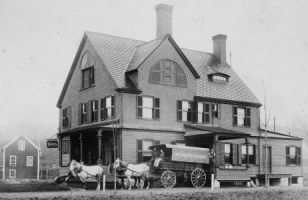 [C]
The Creamery was built by J. R. Whipple to process milk from his Valley View Farm's dairies. It had a steam-powered pump to provide water to hydrants around town to ensure a devastating fire would not happen again.
[C]
The Creamery was built by J. R. Whipple to process milk from his Valley View Farm's dairies. It had a steam-powered pump to provide water to hydrants around town to ensure a devastating fire would not happen again.
There is much more information about the Creamery and J.R. Whipple on the "About the Farm" page.
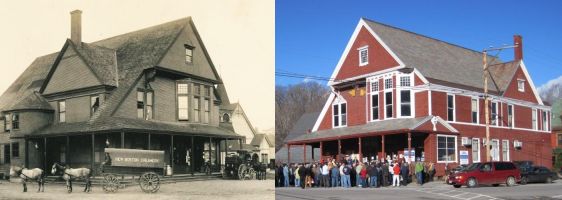 [D]
Dodge's Store was built after the Fire of 1887 on the site of an earlier 3-story general store. It was owned by four generations of Dodges. This building once housed the first public library and the New Boston post office. There is more information on the "General Stores" page.
[D]
Dodge's Store was built after the Fire of 1887 on the site of an earlier 3-story general store. It was owned by four generations of Dodges. This building once housed the first public library and the New Boston post office. There is more information on the "General Stores" page.
In the old photo, the Baptist Church is just visible on the village green beyond the store. The horse-drawn New Boston Creamery van is heading towards the Creamery which to just out of sight to the left.
 [F]
The playground behind Town Hall was once the site of Fourth of July celebrations. In the 1920s, Reverend Louis Swanson encouraged the town to buy two acres of land to build a community playground. In little more than one day, the land was cleared and grandstand seating for 600 people was built and painted.
[F]
The playground behind Town Hall was once the site of Fourth of July celebrations. In the 1920s, Reverend Louis Swanson encouraged the town to buy two acres of land to build a community playground. In little more than one day, the land was cleared and grandstand seating for 600 people was built and painted.
A new post-and-beam structure was built in 2008 by volunteers to replace the old grandstands that had seen many baseball games.
 [G]
Clarence Dodge's first general store was in the red brick house which is across High Street from the bank.
If you thought that Dodge's Store is on the other side of the river today (it is) then you really must read the "General Stores" page to become unconfused.
[G]
Clarence Dodge's first general store was in the red brick house which is across High Street from the bank.
If you thought that Dodge's Store is on the other side of the river today (it is) then you really must read the "General Stores" page to become unconfused.
Roger Babson's Gravity Research Foundation once held meetings in this Brick Building, and there is a monument to Anti-Gravity in the traffic island nearby.
 [H]
The Historical Society museum is in the Wason Memorial Building, built in 1927 to serve as the Whipple Free Library. The Historical Society relocated here when the library moved to its new site in 2011.
[H]
The Historical Society museum is in the Wason Memorial Building, built in 1927 to serve as the Whipple Free Library. The Historical Society relocated here when the library moved to its new site in 2011.
Items on display in the museum include: the 1743 "Molly Stark" cannon in the care of the New Boston Artillery Company, the Tavern carriage once used to meet hotel guests at the train station, products made in New Boston's mills and workshops, and a golden eagle shot while carrying off a hunter's beagle.
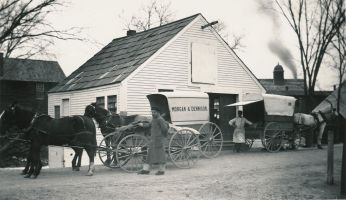 [M]
The Morgan & Dennison Meat Market had a large upstairs door for ice to be hoisted up and in.
The building later became a bakery and then a café.
[M]
The Morgan & Dennison Meat Market had a large upstairs door for ice to be hoisted up and in.
The building later became a bakery and then a café.
It's on Mill Street; the brown building just visible between the Historical Society and Parker's Mill in the photo above. In good weather, enjoy your coffee on the balcony which has a nice view of the mill and the Piscataquog River.
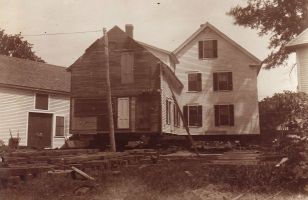 [N]
Nan's House attached to the Community Church once stood where the Historical Society building now stands. Then called the Saltmarsh house, it was moved across Mill Street to make way for the Wason Memorial Building, built in 1927 to be a library.
[N]
Nan's House attached to the Community Church once stood where the Historical Society building now stands. Then called the Saltmarsh house, it was moved across Mill Street to make way for the Wason Memorial Building, built in 1927 to be a library.
In this photo, the house has been jacked up and put on steel rails to be moved. You can see Nan's house today to the left of the Historical Society / Wason Memorial building in the photo above.
 [O]
The Old Engine House was the village fire station. It burned in the Fire of 1887 and was rebuilt. Fire hoses were hauled up inside the tower to drain the water out.
[O]
The Old Engine House was the village fire station. It burned in the Fire of 1887 and was rebuilt. Fire hoses were hauled up inside the tower to drain the water out.
The Old Engine House later served as the Town Clerk's office and the Historical Society building, and now houses the Recreation Department. The iron fence now in front of the building came from the old Depot Bridge.
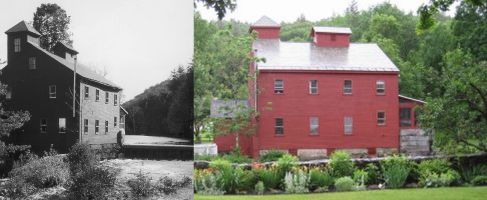 [P]
Parker's Mill was one of the first buildings in the village center It was built around 1803 as a grist mill.
[P]
Parker's Mill was one of the first buildings in the village center It was built around 1803 as a grist mill.
The mill survived the Fire of 1887 and later became a Merrimack Farmers' Exchange, selling grain and coal and baby chicks. It is now a private home. The mill dam floated away during a flood about ten years ago and cannot be rebuilt.
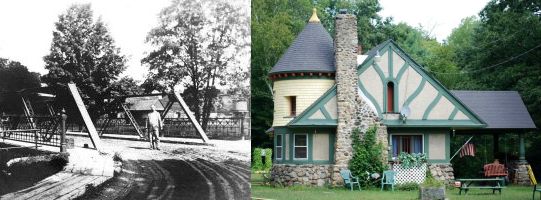 [R]
The present bridge to the Railroad Depot is modern. Ornate fences from the earlier bridge in the photo may be seen at the Old Engine House (Recreation Department office).
[R]
The present bridge to the Railroad Depot is modern. Ornate fences from the earlier bridge in the photo may be seen at the Old Engine House (Recreation Department office).
The actual Railroad Depot building is just out of the bird's-eye view / aerial photo to the left of the bridge. After the railroad closed in the 1930s the Depot served as a community center, a police station, and a pre-school called "Little People's Depot". It is now a private home.
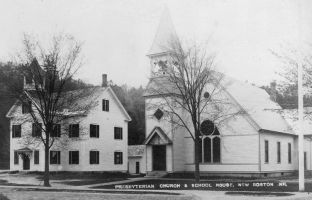 [S]
The New Boston High School (to the left of the church in the photo) was demolished in 1971 to make way for a fire station. It was the village school with 12 grades before the Central School was built in the 1950s.
[S]
The New Boston High School (to the left of the church in the photo) was demolished in 1971 to make way for a fire station. It was the village school with 12 grades before the Central School was built in the 1950s.
Howard Towne said this school taught students everything they needed to know to live a good life. He learned farming techniques in its Vocational/Agricultural class and was taught woodworking and blacksmithing by the principal himself in a workshop behind the school.
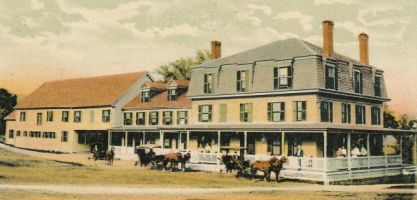 [T]
The Tavern was originally called the Columbian Hotel. After it was torn down in the 1940s, its wagon shed was relocated to where The Tavern once stood and renovated to become a bank.
[T]
The Tavern was originally called the Columbian Hotel. After it was torn down in the 1940s, its wagon shed was relocated to where The Tavern once stood and renovated to become a bank.
Of course, there is more information on "The Tavern" page.
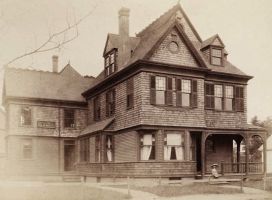 [V]
The violin-maker Charles Farley (1846-1927) had his workshop in this house. Charles worked in his father's piano factory before starting his own business. He made 450 instruments, some from the wood of old furniture. At least one violin is in the collection of the Museum of Fine Arts in Boston.
[V]
The violin-maker Charles Farley (1846-1927) had his workshop in this house. Charles worked in his father's piano factory before starting his own business. He made 450 instruments, some from the wood of old furniture. At least one violin is in the collection of the Museum of Fine Arts in Boston.
Charles moved to Massachusetts after his wife Julia perished in the river behind their house.
 [W]
The Town Hall was dedicated May 11, 1888, exactly one year after the old Town Hall burned.
The large room on the second floor served as a theater for movies and plays and had a basketball court.
Until a gymnasium and kitchen were added to the Central School, students would trudge down to the Town Hall in all kinds of weather for lunch and gym class.
[W]
The Town Hall was dedicated May 11, 1888, exactly one year after the old Town Hall burned.
The large room on the second floor served as a theater for movies and plays and had a basketball court.
Until a gymnasium and kitchen were added to the Central School, students would trudge down to the Town Hall in all kinds of weather for lunch and gym class.
A volunteer regularly climbs up into the bell tower to rewind the clock mechanism. The Town Hall is also the home of the Joe English Grange.
 [X]
The Community Church was rebuilt after the Fire. It has a Paul Revere bell which once hung up in the Church On The Hill on Bedford Road. (That hilltop church did not burn in 1887, but when it was struck by lightning in 1900 its flames could be seen from Manchester. Fortunately its bell had been moved to the church in the village.)
[X]
The Community Church was rebuilt after the Fire. It has a Paul Revere bell which once hung up in the Church On The Hill on Bedford Road. (That hilltop church did not burn in 1887, but when it was struck by lightning in 1900 its flames could be seen from Manchester. Fortunately its bell had been moved to the church in the village.)
Bibb Elliot remembered that the men in town would cut and split a year's supply of firewood and throw it down into the basement of the Community Church to feed the wood furnace.
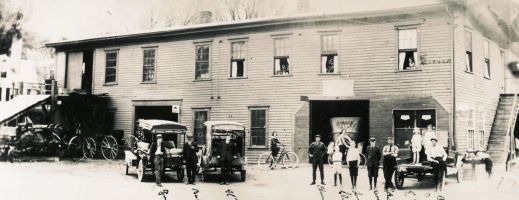 [Y]
This building was originally a blacksmith's shop. A ramp led to a carriage painter's shop on the second floor.
[Y]
This building was originally a blacksmith's shop. A ramp led to a carriage painter's shop on the second floor.
In the 1940s the building was converted into the Cathedral neck-tie factory. Later it was a NAPA autoparts store. The building was torn down to make way for the garden center that is on this site today.
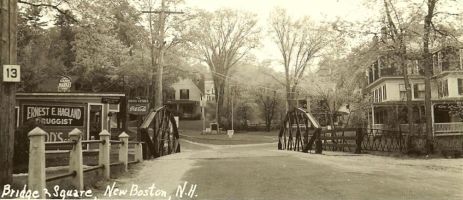 [Z]
Hagland's Pharmacy was one of several drugstores which occupied the building which is now an art gallery and insurance agent's office. If you look closely you can see the Coca Cola sign which announced that Hagland had a soda fountain. A stronger beverage might be found in The Tavern which is visible to the right of this photo, which looks west across the bridge from the center of the village.
[Z]
Hagland's Pharmacy was one of several drugstores which occupied the building which is now an art gallery and insurance agent's office. If you look closely you can see the Coca Cola sign which announced that Hagland had a soda fountain. A stronger beverage might be found in The Tavern which is visible to the right of this photo, which looks west across the bridge from the center of the village.
Hagland's building was also the site of Pringle's Store. For a number of years it was Hunter's Angling Supply, and fishermen could be seen in the street, experimentally fly-casting.

New Boston village before the Fire of 1887, looking west from Meetinghouse Hill.
The Presbyterian Church is to the left, a white 3-story general store is in the middle, and the Town Hall and Baptist Church are to the right.
Buildings like The Tavern (just left of center, with flagpole) on the other side of the river survived the fire.
